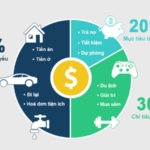If you’re a fan of financial management-related games, then Cashflow 101 is a must-try. This board game will teach you how to effectively manage your personal finances. Learn more about this exciting game in the article below!
1. Introduction to Cashflow 101 Board Game
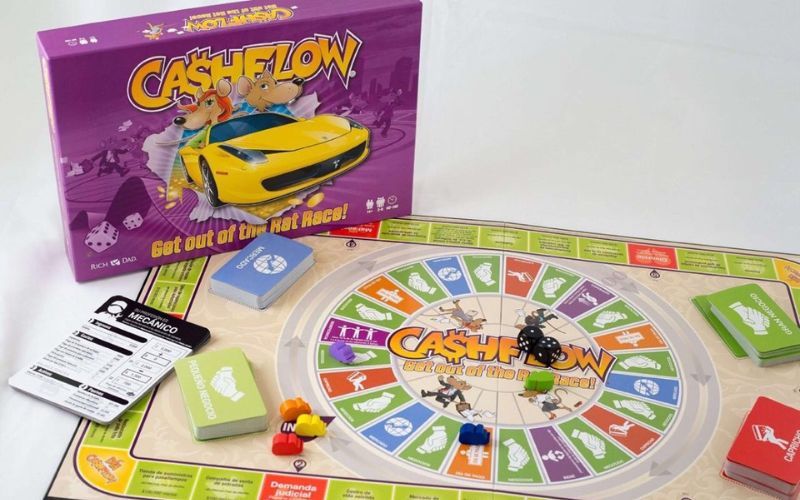 Introduction to Cashflow 101 Board Game
Introduction to Cashflow 101 Board Game
This game can be called the “cash flow wheel” and was developed by investor-entrepreneur Robert Kiyosaki, releasing in 1996. It is designed to help players understand financial strategies and basic accounting principles.
Cashflow 101 accurately depicts the life of a person from their childhood, education, work life, to their retirement. Throughout this journey, one is bound to face opportunities and challenges, both big and small. To break free from this cycle, you need to find the optimal solution, and Cashflow 101 will guide you to become the winner in this financial constraint loop.
For further reference: Basic Guide, Expanded
2. Learn the Rules of Cashflow 101 Board Game in 5 Minutes
 Learn the Rules of Cashflow 101 Board Game in 5 Minutes
Learn the Rules of Cashflow 101 Board Game in 5 Minutes
Cashflow 101 offers two gameplay modes:
- Rat Race: In this mode, you play a small round of the Rat Race, using one die each turn. The objective is to get out of the Rat Race by being the first player to cross the finish line.
- Fast Track: Here, you will play two rounds. The first is the small Rat Race round, and the second is the larger Fast Track round. You use two dice each turn, and the goal is to either accumulate an additional $50,000 in monthly income or fulfill your dream.
3. How to Play Cashflow 101 Board Game
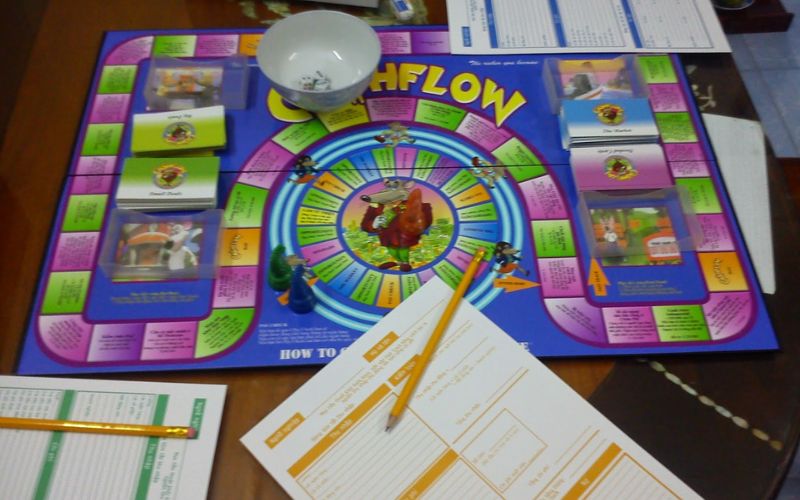 How to Play Cashflow 101 Board Game
How to Play Cashflow 101 Board Game
The Cashflow 101 game board is divided into two sections, each corresponding to the two gameplay modes: Rat Race and Fast Track.
- Rat Race: In this section, players move their tokens around the board, encountering opportunities, losses, market information, and receiving a monthly income. To advance to the next level and exit the Rat Race, players must complete investment tasks and financial activities.
- Fast Track: This section is a race against time as players strive to complete deals and fulfill their dreams by making investments or achieving their set goals.
The financial report includes the following elements:
- Active income
- Passive income
- Total income
- Expenses
- Childcare expenses
- Total expenses
- Monthly cash flow
- Assets and liabilities
Components of the Cashflow 101 Board Game
- A game board
- Financial reports, pencils, and erasers
- Player tokens
- Dice
- Money cards
- Various decks of cards, including Opportunity, Doodad, Market, and Charity cards
- Career cards
Initial Game Setup
 Initial Game Setup
Initial Game Setup
Before starting the game, it is recommended to choose one player to act as the bank, who will guide, instruct, and manage the overall gameplay. Each player is then provided with the following:
- Career cards
- Financial reports, erasers, and pencils
- Tokens to represent themselves on the board
- Dream cards
- Separate and place the decks of cards (Big Deal, Small Deal, Doodad, and Market) face down in their respective positions on the game board.
Detailed Game Rules
How to Play the Rat Race Round
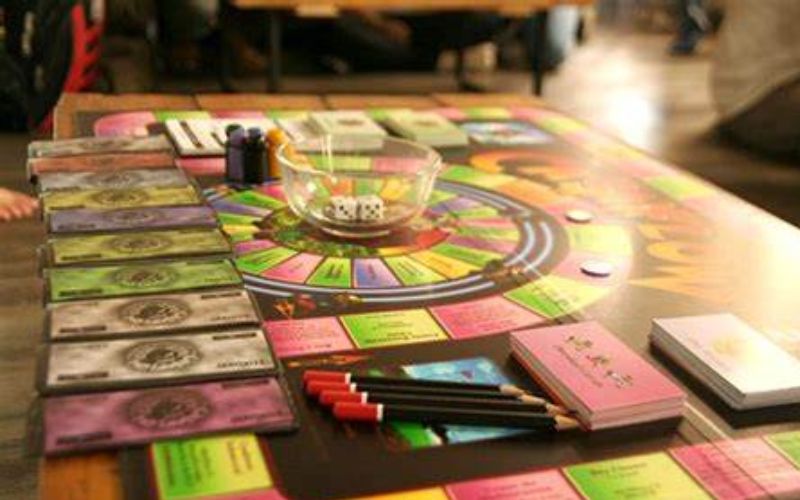 How to Play the Rat Race Round
How to Play the Rat Race Round
Each player places their token on the “Start Here” space and chooses who will go first. On their turn, a player rolls one die, moving their token the corresponding number of spaces. The player then performs the action indicated on the space where their token lands.
- Opportunity Space: Players draw a card from either the Small Deal deck (small opportunities with low investment and low returns) or the Big Deal deck (larger opportunities with higher investment and higher returns).
- Doodad Space: Players draw a Doodad card and pay the corresponding expense indicated on the card.
- Market Space: Players receive market information by drawing a card, which provides them with options to buy or sell assets.
- Charity Space: Players have the option to donate 10% of their total income to charity or not. If they choose to donate, they get to roll two dice for their next three turns.
- Paycheck Space: Players receive their monthly income as indicated on their financial report.
- Baby Space: Players may have up to three children, and for each child, they incur additional childcare expenses.
- Downsize Space: Players lose two turns and must pay their monthly expenses.
At the end of the round, the player with passive income greater than their total expenses wins and advances to the next round, leaving the Rat Race behind.
How to Play the Fast Track Round
. Players must pay the corresponding amount to seize these opportunities.</li>
<li><b>Pink Spaces:</b> Players can purchase their dreams by paying the cost indicated on these spaces. If a player acquires their dream, they win the game.</li>
<li><b>Cashflow Day Space:</b> Similar to the Paycheck space in the Rat Race round, players receive their monthly income.</li>
<li><b>Charity Space:</b> Players can choose to donate $100,000 to charity and receive three dice (no limit on the number of times this can be done). This allows them to roll a minimum of one die and a maximum of three dice on their turns.</li>
<li><b>Purple Spaces:</b> Players incur a loss, as indicated on the space.</li>
</ul>
<p><b>The first player to accumulate $50,000 in passive income wins the Fast Track round and the game.</b></p>
<p><quote><b>For further reference</b>: Simplified Guide for Beginners</quote></p>
<h3>4. Where to Play Cashflow 101 Board Game Online</h3>
<p><img decoding=) Where to Play Cashflow 101 Board Game Online
Where to Play Cashflow 101 Board Game Online
While Cashflow 101 is an entertaining game, it also offers valuable lessons in financial management and understanding your cash flow. You can download apps or visit online websites to play Cashflow 101 at the following links:
- https://wesave.vn/download-game-cashflow-101-tieng-viet-mien-phi-free/
- https://fanrichdad.wordpress.com/2014/12/17/link-download-mien-phi-game-cashflow-viet-hoa-cashflow-101-202-viet-hoa-free/
- https://shaolin.cn.com/download-game-cashflow-tieng-viet-full/
5. Notes and Tips for Playing Cashflow 101 Board Game
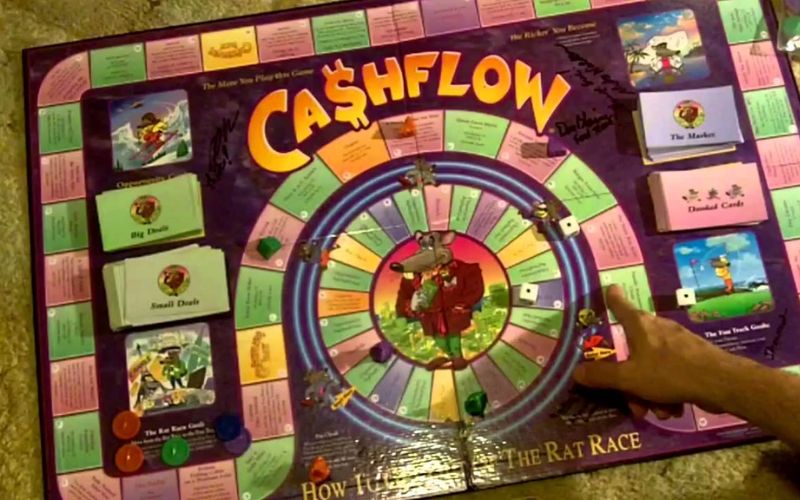 Notes and Tips for Playing Cashflow 101 Board Game
Notes and Tips for Playing Cashflow 101 Board Game
- Bank Support and Prepayment: Understand that for this type of asset, the bank will support you with a portion of the cost, and you will prepay the remaining amount. The interest on the loan from the bank will be deducted from the actual income generated by the asset, and the remaining balance is the cash flow stated on the asset.
- Bank Loan: You are allowed to take out a bank loan that does not exceed your credit limit (when paying the monthly bank loan expense, your monthly cash flow remains positive). The minimum loan amount is $1,000, and for each loan, you must pay 10% of the loan amount per month.
- Debt and Insolvency: When your monthly cash flow becomes negative, you will lose three turns and be forced to liquidate your assets to repay the debt, essentially going bankrupt at that point. If you are unable to clear your debts, you are eliminated from the game.
The above guide to playing Cashflow 101 offers insights into this fascinating and engaging game. Through gameplay, you will learn valuable lessons about financial management, cash flow control, and making informed decisions about income and expenses to achieve a more fulfilling life.
Exploring Deception and Murder in the Hong Kong Board Game
Do you have what it takes to uncover the truth and apprehend the killer? Put your detective skills to the test in Deception: Murder in Hong Kong, the deduction game of murder mystery and intrigue. Deduce the murderer, the weapon used and the secret evidence from the crime scene. With plenty of plot twists to keep you guessing, can you solve the puzzle and get to the bottom of the case?
A Comprehensive Guide to Playing One Piece: Toonies Boom
Are you ready to take on your competitors in the adrenaline-pumping board game, Toonies Boom? Based on the renowned manga series, One Piece, this exciting game gives players the opportunity to have an explosive battle and have the last laugh. Will you be able to prove that you have what it takes to survive? Play and find out!





























